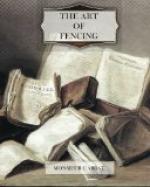CHAP. XXVI.
Of Time.
If we were to follow the exact Term of Time, every Thing that is done in Fencing might be called so; for you shou’d never thrust but when you have a favourable Opportunity of hitting, nor parry, but at the Time that favours you to oppose the Enemy’s Sword, not make an Engagement, nor a Feint, but to take the Time upon the Motion that your Action occasions in the Adversary.
Time is the Duration of any Motion: It is called Time because it is the most favourable Opportunity of pushing, the Enemy being unable during one Action to do a contrary one.
It is divided into several Manners and Terms: The first is called the Time, the second, taking his Time, the third, Time to Time, the fourth, the same Time, and the fifth, false Time.
1. Taking the Time, is making your Thrust by a judicious Discernment on the Motion of the Enemy, taking him by a contrary one: You are to know that every Motion, of whatever Part it be, is called Time; for which Reason, I shall say nothing of Feints, Engagements, and Disengagements, upon which it may be taken; and that in three Manners, viz. strait, lowering the Body, or volting it, which you must know how to apply. In a strait Thrust the Time shou’d be taken by lowering and volting the Body, because the Thrust coming strait, if you were to push the same Way, you would, by supporting the Wrist, make a Contrast; and by pushing crooked, you would make a Coup Fourres, or an interchanged Thrust; but if the Thrust be in Two Times, or Motions, you may push on the first; If it be in three Motions, on the second. As to the volting and lowering the Body, they may be used on all Motions, provided they be abandoned, and that the Enemy does not keep back his Body to draw you on.
2. Taking his Time, is the most subtle Thing in Fencing, depending principally on the Mind: The Manner of taking it proceeds from your Place or Situation, which gives you an opportunity of knowing the fort and the feeble of the enemy, so that feeling his blade with your’s, you may by a judicious custom, push at a proper instant, according as you find the weakness of his sword; and though it may seem that the enemy, in the same guard, and at the same distance, can as easily parry; that does not happen because of his different design to push, disengage, or make a feint, by reason of the several operations of the mind which follow the will.
3. The Time to Time, or the Counter to Time, is by several people, called Counter-time: this cannot in effect alter this necessary part of the art; it being but an impropriety in terms; when they say that making a motion to bring the Enemy on, and when he is going to make a Thrust, the making a Counter; this is by consequence a Counter Time, like a Counter-disengagement, without observing that a Counter-time is nothing but an ill timed Motion, which should upon all occasions




